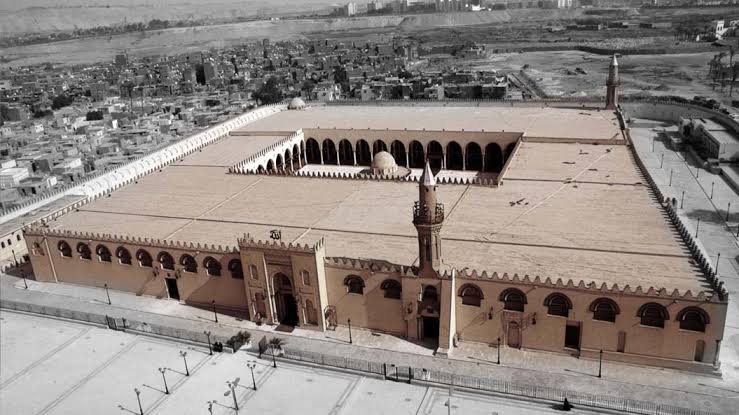Mosque of Amr ibn al-As
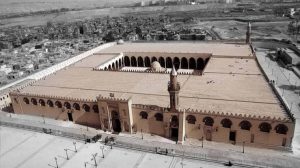
The Mosque of Amr ibn al-As
The Arabs entered Egypt in 642 AD, led by Amr ibn al-As, who had previously visited Egypt and knew that the keys to the state were in its capital, Alexandria, from which the Romans ruled the country. The Romans were oppressing the Christians of Egypt due to the difference in religious philosophy between the church in Rome and the church in Alexandria. They persecuted the monks of the church, forcing the pope to flee to the desert from the tyranny of the Romans. When Amr entered Egypt, he did not find much resistance from the Roman garrison in Alexandria. So he marched with his soldiers to Cairo and issued an amnesty for the pope of the Egyptian church, who had been persecuted by the Romans, thus winning the hearts of the Egyptians. And he decided to build a mosque in the center of his new capital (Fustat), in the middle of Cairo. This was in imitation of the Prophet’s Sunnah, peace be upon him, who built a mosque when he entered Medina. Therefore, Amr established a mosque on the same model as the Prophet’s Mosque in Medina. And the mosque here is considered not only a place for prayer but also a seat of government. As Amr decided to change the capital from Alexandria to Cairo in order to protect Egypt from Roman invasion via the Mediterranean Sea.
 The Mosque of Amr ibn al-As faced
The Mosque of Amr ibn al-As faced
The role of the mosque in Islam
After the Arab conquest of Egypt and some people entering the Islamic religion, it became necessary to learn more about this new religion and how to practice its rituals. Here, the mosque became a place for prayer and learning about religious matters. Therefore, when Amr built the mosque (642 AD), the mosque became a place for prayer and a university for spreading and teaching Islam.
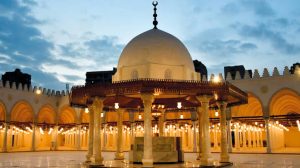 The Courtyard for The Mosque of Amr ibn al-As
The Courtyard for The Mosque of Amr ibn al-As
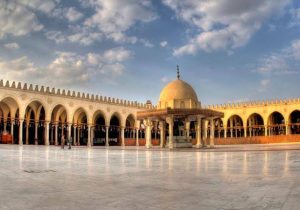 The Courtyard for The Mosque of Amr ibn al-As
The Courtyard for The Mosque of Amr ibn al-As
The Fame of the Mosque of Amr
Amr ibn al-As established a new capital in the middle of Cairo, naming it Fustat (meaning “tent”). Just as the Prophet’s Mosque in Medina had a political, social, and economic role, so too did the Mosque of Amr ibn al-As in the city of Fustat. It became a seat of governance, a treasury, and the exclusive venue for Friday prayers, despite the existence of other mosques built afterward. It became a media and political platform for whoever held the reins of power. For this reason, it gained immense popularity among Egyptians, especially the poor who came to receive Zakat (Gifts for the poor) and donations. Egyptians have blessed it through generations and continue, to this day, on the last night of Ramadan, to perform religious rituals at the Mosque of Amr ibn al-As.
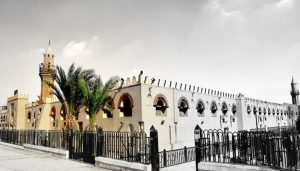 Outside view for the mosque
Outside view for the mosque
Description of the Mosque
When it was first built, it was a miniature image of the Prophet’s Mosque. It consisted of a small courtyard for prayer with a place for ablution in the middle. It occupied an area of 25 meters by 15 meters, and its floor was made of sand and gravel. The columns were palm trunks, and the roofs were made of palm fronds. Throughout the Islamic eras, additions were made to it because it was considered the main mosque in the capital. Its area was expanded, and minarets were built. The current minarets date back to the Ottoman era (1517-1805 AD). In October 1992, an earthquake in Egypt caused significant damage to the mosque, leading to its restoration.
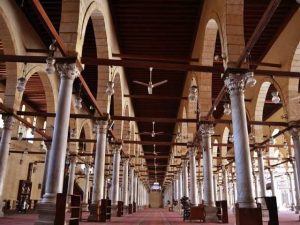 Differents scences from inside the mosque
Differents scences from inside the mosque
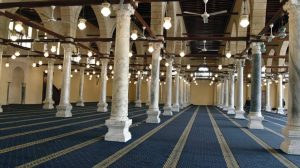 Differents scences from inside the mosque
Differents scences from inside the mosque

